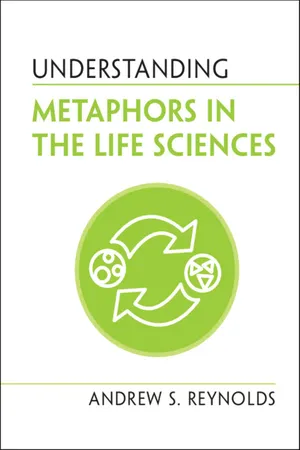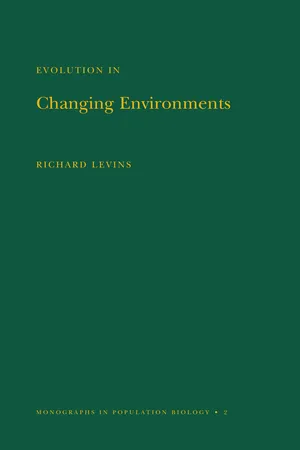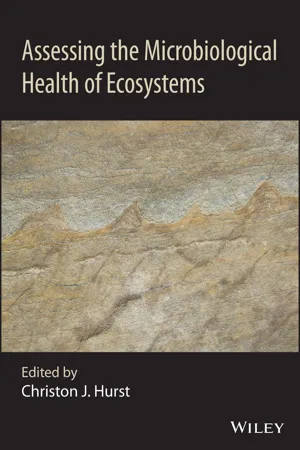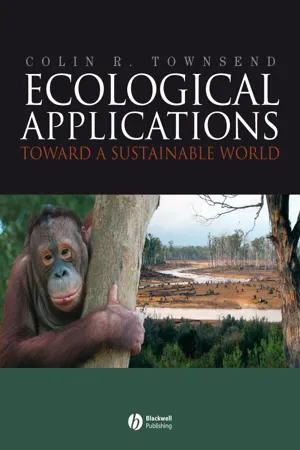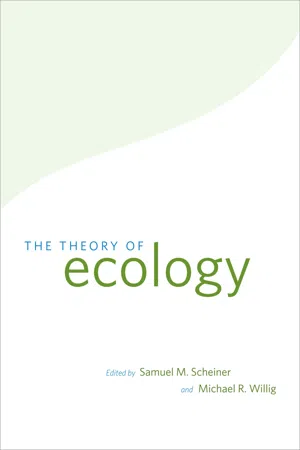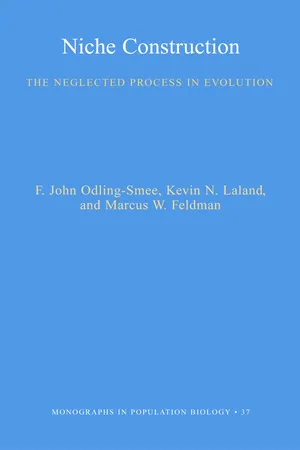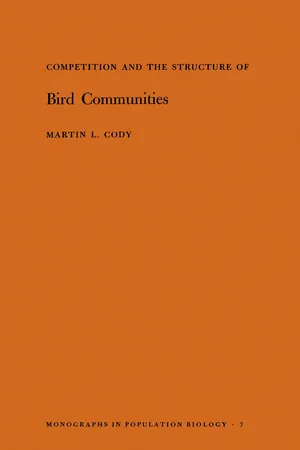Biological Sciences
Niches
In the field of biological sciences, a niche refers to the specific role or function that an organism has within its ecosystem. This includes its interactions with other species, its habitat requirements, and its resource utilization. Understanding an organism's niche is crucial for studying its ecological relationships and predicting its responses to environmental changes.
Written by Perlego with AI-assistance
Related key terms
1 of 5
10 Key excerpts on "Niches"
- eBook - PDF
- Andrew S. Reynolds(Author)
- 2022(Publication Date)
- Cambridge University Press(Publisher)
The concept of an ecological niche has been very influential, but has also been developed in at least two fundamentally distinct ways. One version construes the niche in largely spatial terms as the physical or environmental Figure 7.1 A literal niche. Niche with a sculpture by Antoine Coysevox, in the Les Invalides, Paris (Creative Commons Attribution Share-Alike 3.0 Unported licence; https://commons.wikimedia.org/wiki/File:Paris_-_D%C3%B4me_des_Invalides_- _Statue_-_PA00088714_-_003.jpg). 122 UNDERSTANDING METAPHORS IN THE LIFE SCIENCES space in which an organism lives; this is often known as a “habitat niche.” Another treats the niche in terms of the organism’s role in or contribution to the ecological community, and is known as a “functional niche.” Niches can be operationally defined in terms of abstract geometrical spaces wherein various biotic and abiotic factors relevant to the species are measured and represented for further mathematical analysis. A common assumption in earlier thinking about Niches was that, like a physical space or an occupation in an economy, Niches can exist separately from the organism that occupies it. This is an analogy quite evidently suggested by the metaphor’s source because a literal niche is an empty space that may or may not be occupied by a statue. Another assumption that appears to have been naturally suggested by the metaphor was that similar Niches could exist in different environments or regions, and that a niche occupied by one species in one environment could be filled by a different species in another. For example, in the case of Darwin’s finches on the Galapagos Islands, one species of finch is described as occupying a niche typically filled by woodpeckers on the main- land, and presumably before this species began to exploit this niche by feeding on insects that live on trees and under the outer bark, the niche remained vacant. - eBook - PDF
Ecology
Principles and Applications
- J. L. Chapman, M. J. Reiss(Authors)
- 1998(Publication Date)
- Cambridge University Press(Publisher)
Figure 10.2 shows the range of micro- habitats available to insect herbivores and fungal parasites on a typical flowering plant. Of course, few plants are so unfortunate as to be attacked by all these organisms at the same time! 10.2 Niches The distinction between habitat and niche is an important one in ecology. The word niche originally meant a shallow ornamental recess formed in the wall of a building, usually for the purpose of contain- ing a statue or other decorative object. In ecology it came to stand for the precise way in which a species fits into its environment. A habitat is a description of where an organism is found, but its niche is a complete description of how the organism relates to its physical and biological environment. The concept of the niche has been very important in ecology, but it takes a great deal of field work to determine the niche of an organism in any detail. 10.2.1 Determining Niches In his classic book Animal Ecology Charles Elton pointed out that the word niche should be used to indicate what an animal was actually doing in its community. 'When an ecologist says "there goes a badger" he should include in his thoughts some definite idea of the animal's place in the community to which it belongs, just as if he had said "there goes the vicar'"(Elton, 1927, p. 64). A complete account of the niche of a badger would therefore include some 106 20.2 Niches Dispersed pollen Typhlodromus pyri (Mite) Pollen (Meligethes) (Beetle) Ovary galls (Kiefferia) Ovules and seeds Bruchid beetles Specialists on young leaves (many Hemiptera) Leaf biters Lepidoptera larvae etc. - eBook - PDF
Evolution in Changing Environments
Some Theoretical Explorations
- Richard Levins(Author)
- 2020(Publication Date)
- Princeton University Press(Publisher)
CHAPTER THREE The Theory of the Niche The concept of the ecological niche has been used heuristi-cally for a long time. Grinnell (1904) referred to the Niches of birds to indicate that different species have different requirements. Elton (1927) used the niche mostly for defin-ing a species' position in the trophic hierarchy. Biogeogra-phers have long noted the apparent equivalence between organisms of different regions and corresponding numbers of species in corresponding formations. For instance, in Table 3.1 we show the percentages of bird species of the Maylayan and Australian rain forests in each level of the forest and for each food category. This correspondence sug-gests that the relative abundance of opportunities for species of each type, or the number Niches, is the same in both forests. The notion of saturated environments versus those with empty Niches has been used to compare insular and continental biotas. Finally, the classical experiments of Gause (1934) led to the exclusion principal: if two species coexist they must occupy different Niches. But it was due to the work and inspiration of G. E. Hutchinson (1965) that progress has been made toward a rigorous theory of the niche. A satisfactory theory of the niche must permit an accurate description of a species' niche, and must be able to use that description to answer the following questions: 1. What determines the degree of specialization of a species, or inversely, its niche breadth? 2. What determines the species diversity of a community in relation to area, climatic region, size of organism, trophic level, etc? 3. How similar can species be and yet coexist? 4. How do similar species divide the environment among them? 39 - Christon J. Hurst(Author)
- 2022(Publication Date)
- Wiley(Publisher)
His pro- posal has been described as the Eltonian niche, which represents the functional attributes of a species and its corresponding position in a trophic chain. 1.2.3 Evelyn Hutchinson’s 1957 Description of an Ecological Niche Evelyn Hutchinson subsequently proposed the concept of Niche Space along with the concept of biotop (Hutchinson 1957). He used the niche concept previously published by Joseph Grinnell (Grinnell 1917) which represented aspects defining where a species resides. Hutchinson did include one aspect of the eco- logical role played by members of the species, and that was an indication of the food particles consumed by members of the species. 1.3 How Does a Species Become Established in a Niche? An ecological niche is a function, or collection of functions, that is part of the metabolic activ- ity which occurs within a defined location. That location is the habitat. Biological life forms constantly are trying to find sources of usable energy which can sustain their meta- bolic needs and, once an opportunity for obtaining energy is found, evolution will opti- mize a biological life form to use that energy. The members of a species will need a means to physically reach and remain in reasonable proximity to their energy sources. The mem- bers of a species also will need to obtain many other resource materials, including minerals, which are necessary for sustaining the mem- bers vital functioning, because without those other resource materials the source of energy cannot be utilized. The niche of a species includes both its use of those resources plus any additional activi- ties which its members perform, including its associated physical or chemical modifications of the environment. The members of a species may have necessity for establishing beneficial working relation- ships with other species which cooperatively can help with the process of obtaining neces- sary resources.- eBook - PDF
Ecological Applications
Toward a Sustainable World
- Colin R. Townsend(Author)
- 2009(Publication Date)
- Wiley-Blackwell(Publisher)
The middle ground is occupied by both exploiters and conservationists whose basic philosophy holds that natural resources can be used, but this should be in a sustain- able and balanced manner. A good understanding of ecology can provide the scien- tific basis for what, in its broader context, is a question of ethics. A successful species invasion (of Kelly’s introduced brown trout, for example) depends on the ability to establish and maintain a population in a new location. To do this, individuals must tolerate the abiotic conditions they encounter, find suffi- cient resources (nutrients, water, food, nest sites and so on), and persist in the face of enemies (competitors, predators, parasites). This is the domain of niche theory (Box 2.1). Niche information is crucial not only when predicting the spread of invad- ers (Section 2.2), but also to design reserves for endangered species (Section 2.3), as well as for species recovery in habitat restoration projects (Section 2.4). In fact, whenever there is a focal species – an invader, an endangered species or one crucial to habitat recovery – the better our understanding of its ecological niche, the more likely the success of a management strategy. 2.1 Introduction 2.1 Introduction Conditions and resources – what’s the difference? Before explaining the term ‘niche’, it is important to distinguish between two kinds of ecological factor – conditions and resources. Conditions are physicochemical features of the environment such as temperature, humidity and pH – these may be altered by the presence of organisms but cannot be consumed. Extreme condi- tions (e.g. high and low temperatures) may be lethal, with a continuum of more favorable values between the extremes. In some cases, the timing and duration of extremes may be more important to an organism’s success than absolute values. - eBook - PDF
- Samuel M. Scheiner, Michael R. Willig, Samuel M. Scheiner, Michael R. Willig(Authors)
- 2011(Publication Date)
- University of Chicago Press(Publisher)
Ecosystems theory (Burke and Lauenroth Chapter 11) examines the fluxes of energy and nutrients through organisms and their abiotic environment. In many circumstances, the traits of species, as defined by their Niches, as well as the diversity and composition of species in a community, influence the impor-tance of their roles in ecosystems. A recent application of niche theory involves species distribution modeling (often called “niche modeling”), which correlates spatiotemporal availability of broad-scale environmental features with species occurrences (e.g., Stockwell 2007). Although species distribution modeling is based on correlations be-tween distribution and environment, and is rather simplistic relative to the 5. Ecological Niche Theory 107 aspects of niche theory discussed here, it has potential to link small- and large-scale processes. Further, such distribution modeling is often used to try to un-derstand how species distributions might be altered by global change (e.g., Pe-terson et al. 2002), and thus provides important linkages with global change theory (Peters et al. Chapter 12). Conclusions Despite repeated attempts over many decades (Grinnell 1917; Elton 1927; Hutchinson 1957; MacArthur 1972; Tilman 1982; Chase and Leibold 2003), niche theory has still not fully reached its potential as a central organizing theory of ecological enquiry. This is in part due to the fact that the niche is such a hard concept to define. Indeed, any definition, verbal or mathematical, of the niche can only represent a caricature of the complexity of any species’ multivariate interactions with its environment and other species. Additionally, niche theory has not traditionally incorporated a variety of complexities, most notably spatiotemporal heterogeneities and stochasticity, which can often play an overriding role in determining the structure of natural communities. - eBook - PDF
Niche Construction
The Neglected Process in Evolution
- F. John Odling-Smee, Kevin N. Lala, Marcus Feldman(Authors)
- 2013(Publication Date)
- Princeton University Press(Publisher)
Also like Hutchinson’s ecological niche, our evolutionary niche has a du- ality. It refers to natural selection pressures relating to the “lifestyles” of organisms, and therefore to the many different ways in which dif- ferent organisms survive and reproduce by actively interacting with their environments, or to what Ehrlich and Roughgarden (1987) call the “occupations” of organisms. It also refers to the real habitats of organisms in real space and time, or to what Odum (1989) calls their “address.” We will again assume that the addresses of organisms can be translated from abstractions to physical realities by observing where and when organisms are found in their environments. Thus, for most practical purposes the niche of a population will be equivalent to its realized niche: that part of its fundamental niche from which it is actually earning its living, from which it is not excluded by other organisms, and in which it is able either to exclude other organisms or to compete with other coexisting organisms. We also want to capture the relativity of this niche concept by EVIDENCE 41 defining at least putative units in terms of which we can describe both how organisms relate to their environments and how environ- ments relate to their organisms. For this descriptive purpose only we will use a scheme originally proposed by Bock (1980), who assumed that any organism can be decomposed into arrays of subsystems (traits or characteristics) which he called features, and that, similarly, any organism’s environment can be decomposed into arrays of sub- systems called factors. However, to correspond with conventional use of the term “adaptation” (Rose and Lauder 1996), here we regard a feature of an organism as an adaptation only if it was favored by prior natural selection arising from one or more environmental factor. - eBook - PDF
Ecological Niches
Linking Classical and Contemporary Approaches
- Jonathan M. Chase, Mathew A. Leibold(Authors)
- 2009(Publication Date)
- University of Chicago Press(Publisher)
If we envision the niche as the relationship between an organism and its environment, then both of these compo-nents are crucial in defining the niche concept. Previous attempts at niche-theoretic definitions had their shortcomings because they fo-cused on one or the other of these two components without a clear synthesis of the two. For example, Hutchinson’s definition focused on requirements and did not do much to account for the ways organisms affected their environment. In contrast, much of the niche theory (see, e.g., Vandermeer 1972) developed in the 1960s and 1970s focused on resource utilization functions that described how organisms removed resources from the environment (i.e., the competition coefficient in the Lotka-Volterra equations) without accounting for how such re-source use translated into fitness. That is, this body of theory focused primarily on impacts. Of course, requirement and impact should be closely related. For example, if assimilation efficiency on every resource were identical, then requirement and impact would be related in a one-to-one manner (see appendix for analytical justification). In such cases, the validity of previous work (i.e., work focused on resource utilization functions) r e v i s i n g t h e n i c h e c o n c e p t 3 1 will be upheld by our approach. This is because under restrictive cir-cumstances, the formalism of our focus on requirements and impacts converges with the Lotka-Volterra models (see chapter 3), although the latter are based on phenomenological parameters while the former are based on mechanistic parameters. However, when there is not a one-to-one relationship between requirement and impact, then many other possibilities arise. This leads us to propose the following formalization: The niche is described by the ZNGI of an organism along with its impact vectors in the multivariate space defined by the set of environmental factors that are present. - eBook - PDF
Paleozoology and Paleoenvironments
Fundamentals, Assumptions, Techniques
- J. Tyler Faith, R. Lee Lyman(Authors)
- 2019(Publication Date)
- Cambridge University Press(Publisher)
A species’ fundamental niche concerns the particular combination of environ- mental variables in which that species can occur; the species’ realized niche incorporates the effects of factors that preclude that species’ occurrence such that it only occurs in a portion of its fundamental niche (Graham 2005; Jackson and Overpeck 2000; Williams and Jackson 2007). The former concerns where a species could occur whereas the latter concerns where a species actually does occur, thus a species’ realized niche tends to be geographically smaller than its fundamental niche (Soberón and Arroyo-Peña 2017). Factors that preclude a species’ presence in an area include competitors, predators, and biogeographic barriers.The distinction between fundamental and realized Niches is important to paleoenvironmental reconstruction because what we perceive to be the FUNDAMENTALS OF ECOLOGY AND BIOGEOGRAPHY 28 28 ecology of a species is based on its realized niche. To infer paleoenvironmental conditions we must assume that the species’ realized niche is a robust reflection of that species’ fundamental niche. The relationship of a species’ realized and fundamental Niches has become increasingly important as efforts to model Niches for purposes of conser- vation biology have become more sophisticated. Greater computing power combined with modeling expertise and growing concerns over accurately predicting how future anthropogenically driven climatic change may influ- ence biota (Dawson et al. 2011) has prompted numerous researchers to con- struct ecological niche models (Morin and Lechowicz 2008; Qiao et al. 2015; Soberón and Nakamura 2009), species distribution models (Austin 2007; Elith and Leathwick 2009), and bioclimatic envelope models (Araújo and Peterson 2012; Polly and Eronen 2011). We will use the generic term biological dis- tribution models to refer to all three kinds of model. - Martin L. Cody(Author)
- 2020(Publication Date)
- Princeton University Press(Publisher)
CHAPTER ONE Resource Division and the Niche I. INTRODUCTION A. Different Sorts of Field Ecology The goal of ecology is to provide explanations that account for the occurrence of natural patterns as products of natural selection. Variation at the level of the phenotype, population, or community must be related to variation in some aspect of environment; two approaches have been employed, that of experimentally induced environmental variation and the use of variation which occurs naturally in the environment. Al-though both methods achieve results, the latter, in which the ecologist gathers observational and mensural data that either discredit or support the explanations, has been obviously suc-cessful. Although lacking the definitive aspects of cause-and-effect demonstrations under controlled conditions from which experimental and manipulative studies benefit, the approach has the advantages of a rapid progression through hypothesis and theory to acceptable and accepted explanations for natural phenomena with economy of time and effort. Two further considerations have been given momentum to the acceptance of this sort of science: a great many questions and problems simply are not amenable to an experimental approach-—many ecologically interesting variables such as cli-mate, competitive milieu, foliage structure, and food level just do not lend themselves to manipulation. Even when such fac-tors are amenable to alteration, there are severe difficulties in arranging for effective controls in field situations. The obvious way around these difficulties in the experi-mental approach, and that usually adopted, is to make use RESOURCE DIVISION AND THE NICHE of the variations in environmental factors which occur natu-rally—the so-called natural experiment. Such variation does not differ conceptually from that induced by an experimenter, and may in fact be a more appropriate test in some instances.
Index pages curate the most relevant extracts from our library of academic textbooks. They’ve been created using an in-house natural language model (NLM), each adding context and meaning to key research topics.
